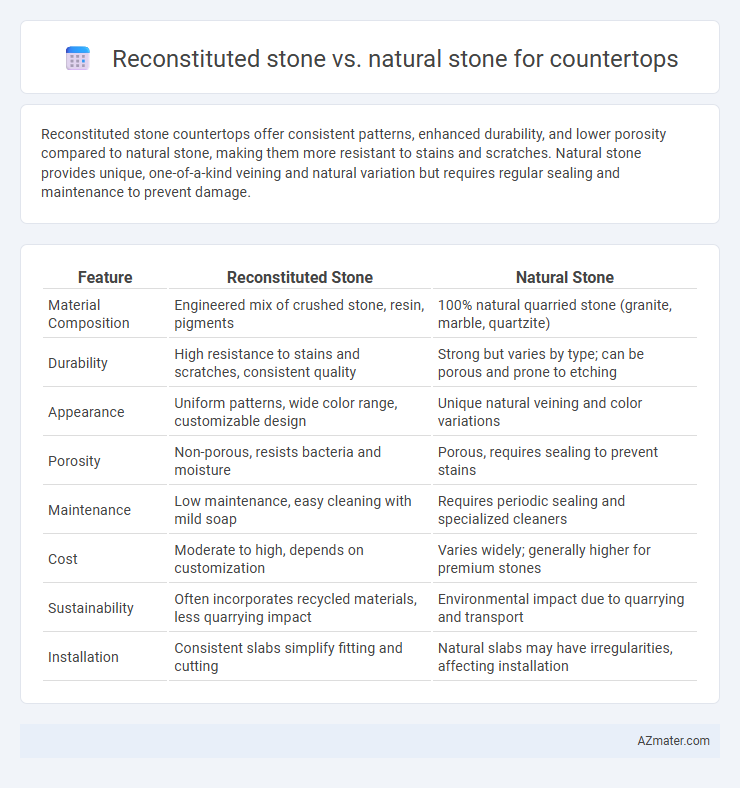Reconstituted stone countertops offer consistent patterns, enhanced durability, and lower porosity compared to natural stone, making them more resistant to stains and scratches. Natural stone provides unique, one-of-a-kind veining and natural variation but requires regular sealing and maintenance to prevent damage.
Table of Comparison
| Feature | Reconstituted Stone | Natural Stone |
|---|---|---|
| Material Composition | Engineered mix of crushed stone, resin, pigments | 100% natural quarried stone (granite, marble, quartzite) |
| Durability | High resistance to stains and scratches, consistent quality | Strong but varies by type; can be porous and prone to etching |
| Appearance | Uniform patterns, wide color range, customizable design | Unique natural veining and color variations |
| Porosity | Non-porous, resists bacteria and moisture | Porous, requires sealing to prevent stains |
| Maintenance | Low maintenance, easy cleaning with mild soap | Requires periodic sealing and specialized cleaners |
| Cost | Moderate to high, depends on customization | Varies widely; generally higher for premium stones |
| Sustainability | Often incorporates recycled materials, less quarrying impact | Environmental impact due to quarrying and transport |
| Installation | Consistent slabs simplify fitting and cutting | Natural slabs may have irregularities, affecting installation |
Introduction to Countertop Material Choices
Reconstituted stone countertops, made from crushed natural stone bound with resin, offer consistent patterns, enhanced durability, and lower porosity compared to natural stone options like granite or marble, which feature unique veining and natural variations. Homeowners prioritize reconstituted stone for its stain resistance, ease of maintenance, and environmental benefits due to recycled content. Natural stone remains favored for its authentic beauty and heat resistance, making material choice dependent on aesthetic preferences, budget, and functional needs.
What is Reconstituted Stone?
Reconstituted stone is an engineered material composed of crushed natural stone, resins, and pigments, designed to mimic the look and durability of natural stone countertops. It offers consistent patterns and colors with enhanced stain and impact resistance compared to natural stone. Ideal for kitchen countertops, reconstituted stone provides a cost-effective, low-maintenance alternative while maintaining aesthetic appeal.
Understanding Natural Stone Countertops
Natural stone countertops, sourced directly from quarries, offer unique variations in color, texture, and veining that enhance the aesthetic value of kitchens and bathrooms. Materials such as granite, marble, and quartzite provide exceptional durability, resistance to heat, and a timeless appeal that increases property value. Understanding the natural porosity and maintenance needs of these stones is essential for preserving their beauty and longevity over time.
Aesthetic Differences Between Reconstituted and Natural Stone
Reconstituted stone countertops offer uniform patterns and consistent colors, allowing for a sleek, modern aesthetic that can be customized to match specific design preferences. Natural stone, such as granite or marble, features unique veining and color variations that create one-of-a-kind surfaces with organic beauty and character. The choice between reconstituted and natural stone ultimately depends on the desired balance between design consistency and natural uniqueness in countertop aesthetics.
Durability and Strength Comparison
Reconstituted stone countertops offer enhanced durability due to their engineered composition, combining crushed natural stone with resin binders that increase resistance to cracking, chipping, and staining. Natural stone, such as granite and marble, provides inherent strength from its solid mineral structure but can be more prone to surface scratches and requires periodic sealing to maintain durability. Overall, reconstituted stone delivers superior impact resistance and consistent strength, making it a practical choice for high-traffic kitchen environments.
Maintenance and Care Requirements
Reconstituted stone countertops require less frequent sealing compared to natural stone, as their engineered composition offers superior resistance to stains and scratches. Natural stone, such as granite or marble, demands regular sealing and more diligent care to prevent etching, staining, and damage from acidic substances. Both materials benefit from routine cleaning with pH-neutral cleaners, but reconstituted stone's homogeneous surface simplifies stain removal and long-term maintenance.
Environmental Impact and Sustainability
Reconstituted stone countertops, made from industrial waste and natural stone dust bound with resins, offer a more sustainable alternative by reducing quarrying and minimizing landfill waste compared to natural stone, which involves extensive extraction and habitat disruption. The production of reconstituted stone typically consumes less energy and generates lower carbon emissions than the mining and transportation processes of natural stone slabs. Choosing reconstituted stone supports resource efficiency and waste reduction, aligning with environmentally conscious countertop solutions.
Cost Analysis: Reconstituted vs Natural Stone
Reconstituted stone countertops generally offer a more budget-friendly option compared to natural stone, with costs typically ranging from $40 to $80 per square foot, while natural stone like granite or marble can cost between $50 and $150 per square foot depending on rarity and quality. Reconstituted stone provides consistent pricing due to its engineered manufacturing process, reducing variability in material and labor costs commonly associated with natural stone, which requires specialized cutting and finishing. Long-term maintenance expenses also differ; reconstituted stone tends to be more stain-resistant and less porous, potentially lowering sealing and repair costs compared to more porous natural stones.
Best Applications for Each Stone Type
Reconstituted stone excels in countertops for kitchens and bathrooms due to its non-porous surface, resistance to stains, and uniform appearance, making it ideal for high-traffic, moisture-prone areas. Natural stone, such as granite and marble, is preferred for luxury countertops and outdoor kitchens because of its unique veining, durability under heat exposure, and ability to enhance aesthetic appeal. Selecting reconstituted stone suits modern, maintenance-efficient designs, while natural stone benefits projects prioritizing authentic texture and long-lasting elegance.
Choosing the Right Countertop for Your Needs
Reconstituted stone countertops offer consistent patterns and enhanced durability, making them ideal for high-traffic kitchens requiring low maintenance and stain resistance. Natural stone countertops, such as granite or marble, provide unique, authentic aesthetics with natural variations but may require regular sealing and care to prevent damage. Choosing the right countertop depends on balancing factors like budget, long-term upkeep, design preference, and functional demands specific to your kitchen environment.

Infographic: Reconstituted stone vs Natural stone for Countertop
 azmater.com
azmater.com